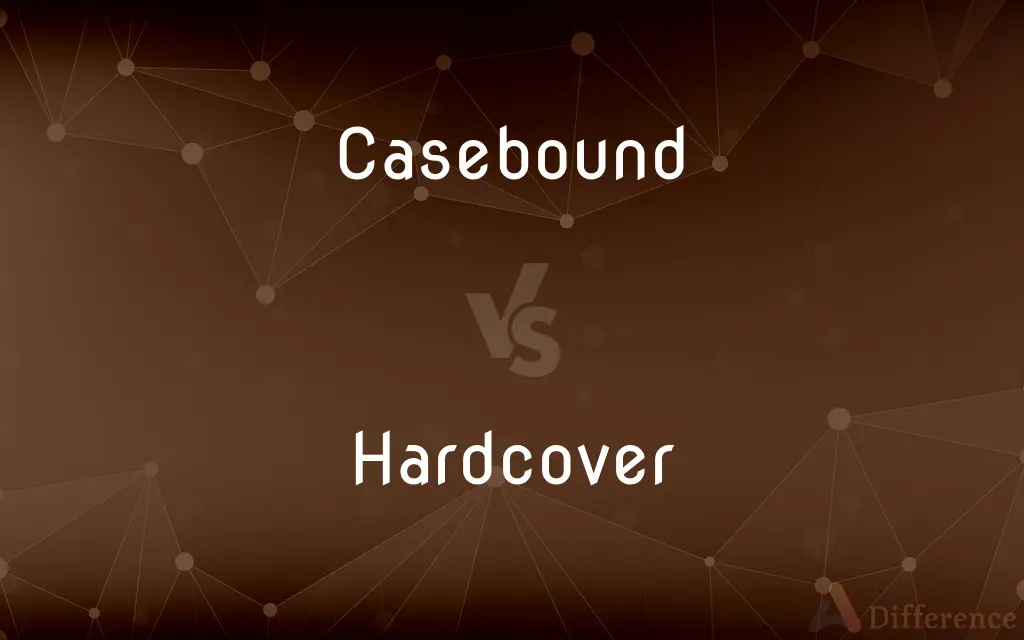Casebound vs. Hardcover — What's the Difference?
By Tayyaba Rehman & Urooj Arif — Updated on April 7, 2024
Casebound books are made by gluing the book block to a hard case cover; hardcover books, while also durable, may use various binding methods, including but not limited to case binding.

Difference Between Casebound and Hardcover
Table of Contents
ADVERTISEMENT
Key Differences
Casebound books are specifically crafted by attaching the book block directly to a sturdy, hard case made of cardboard covered with cloth or paper. This method emphasizes durability and longevity, making it a popular choice for high-quality, archival books. On the other hand, hardcover books generally refer to any book with a hard, protective cover, which can include a variety of binding methods such as case binding, but isn't limited to it. Hardcover is a broader category that may also include additional elements like dust jackets.
While casebound books often have a distinctive, high-quality feel due to the careful selection of materials for the cover, such as cloth, leather, or textured paper, hardcover books can vary more widely in their construction and materials. This variability can influence the book's aesthetic, durability, and cost. Hardcover books might use different grades of paperboard, cloths, or even incorporate other elements like embossing or foil stamping to create unique appearances.
The binding process of casebound books involves several detailed steps, including sewing the pages together, attaching them to the spine of the cover, and often adding endpapers for a finished look. This process ensures a strong, durable binding that allows the book to lay flat when open. In contrast, hardcover books can be bound using various methods, not all of which may offer the same level of durability or ability to lay flat, depending on the specific binding technique used.
Casebound books are typically associated with higher production costs due to the materials used and the labor-intensive binding process. This makes them more common for special editions, textbooks, or reference books that benefit from a durable design. Conversely, hardcover books, while still more expensive than paperback editions, can range in price depending on the specific binding method and materials used, making them accessible for a wider range of books, including novels and general non-fiction.
One key distinction is that casebound books are designed with longevity in mind, making them ideal for libraries, collectors, and anyone looking for a book that will withstand frequent use and the test of time. Hardcover books, while also durable, may prioritize aesthetic and cost considerations, catering to a broader audience that values the hardcover for its protective qualities and premium feel without necessarily requiring the highest level of durability.
ADVERTISEMENT
Comparison Chart
Binding Method
Glues the book block to a hard case cover
Can include various binding methods, not limited to case binding
Material Quality
Often uses high-quality materials like cloth or leather
Material quality can vary widely
Durability
Designed for longevity and frequent use
Generally durable but varies by binding method
Cost
Typically higher due to detailed process and materials
Can range from moderately to highly priced
Ideal Use
High-quality editions, textbooks, libraries
A wide range of books including novels and non-fiction
Compare with Definitions
Casebound
Characterized by its strength and ability to lay flat when open.
I prefer casebound books for cooking recipes since they stay open on their own.
Hardcover
Generally more affordable than casebound, depending on production choices.
Buying hardcover books doesn't have to break the bank if you look for deals.
Casebound
A binding process where the book block is glued into a hard protective case.
The library's rare collection primarily consists of casebound volumes due to their durability.
Hardcover
Refers to any book with a hard protective cover, including various binding techniques.
I love collecting hardcover editions of classic novels for their beauty and durability.
Casebound
Often made with premium materials like cloth or leather for the cover.
Her thesis was finally published as a casebound book with a custom leather cover.
Hardcover
Appeals to a broad audience for its protective qualities and aesthetic value.
Gifted a hardcover photo album, it became a cherished keepsake for its visual and protective qualities.
Casebound
Suited for books intended for heavy use or long-term preservation.
Most textbooks are casebound to withstand years of student use.
Hardcover
Offers a range of material quality, from basic to premium.
This hardcover has a dust jacket and embossed title, making it stand out on my shelf.
Casebound
Associated with a higher production cost.
The casebound edition of the novel is more expensive, but its quality justifies the price.
Hardcover
Can vary in durability based on the specific binding method used.
My favorite cookbook is a hardcover, but I wish it were more resistant to kitchen spills.
Casebound
(of a book) hardcover (attributive)
Hardcover
A hardcover, hard cover, or hardback (also known as hardbound, and sometimes as case-bound) book is one bound with rigid protective covers (typically of binder's board or heavy paperboard covered with buckram or other cloth, heavy paper, or occasionally leather). It has a flexible, sewn spine which allows the book to lie flat on a surface when opened.
Hardcover
(of a book) bound in stiff covers; hardback
Hardcover and paperback editions
Hardcover
A book bound in stiff covers; a hardback.
Hardcover
Having a rigid binding, as of cardboard covered with cloth or with leather. Used of books.
Hardcover
A hardcover book.
Hardcover
A book with a rigid binding, often of cardboard or leather.
Hardcover
(of a book) Having a rigid binding.
Hardcover
A book with cardboard or cloth or leather covers
Hardcover
Having a hard back or cover;
Hardback books
Common Curiosities
Why would someone choose a casebound book?
Someone might choose a casebound book for its durability, high-quality materials, and the ability to lay flat when open, making it suitable for frequent use and long-term preservation.
What is the main difference between casebound and hardcover books?
The main difference lies in the binding method; casebound books are specifically made by gluing the book block to a hard case, while hardcover books can encompass a variety of binding methods.
Are casebound books more expensive than hardcover books?
Yes, casebound books are typically more expensive due to the higher quality materials and more labor-intensive binding process.
Are all hardcover books durable?
While hardcover books are generally more durable than paperbacks, their durability can vary depending on the specific binding method and materials used.
Are dust jackets common with casebound books?
Dust jackets are less common with casebound books, as the focus is often on the quality and design of the actual cover, but they can still be found.
Can hardcover books have different cover materials?
Yes, hardcover books can have a wide range of cover materials, from basic cardboard to premium cloths or leathers.
Can a hardcover book be casebound?
Yes, a hardcover book can be casebound, as case binding is one of the methods used for creating hardcover books.
How are casebound books made?
Casebound books are made by gluing the book block to a hard case made of cardboard covered with cloth, leather, or other materials.
Why do casebound books lay flat when open?
Casebound books are designed with a binding process that allows the spine to remain flexible, enabling the book to lay flat when open.
Do casebound and hardcover books have different target audiences?
Yes, casebound books often target collectors, libraries, and those seeking durable, high-quality editions, while hardcover books cater to a broader audience, including casual readers and gift buyers.
Is case binding the same as hardcover binding?
Case binding is a specific type of hardcover binding, but not all hardcover books are casebound.
What makes casebound books ideal for libraries?
Their durability, ability to withstand frequent use, and longevity make casebound books ideal for libraries.
Are casebound books better than hardcover books?
"Better" is subjective and depends on the needs of the reader or collector; casebound books are superior in terms of durability and quality, but hardcover books offer a wider range of options and price points.
How can you tell if a book is casebound or just hardcover?
You can usually tell by examining the binding method and cover materials; casebound books typically have a more durable, high-quality feel and may lay flat more easily than other hardcover books.
What are the typical uses for hardcover books?
Hardcover books are used for a wide range of purposes, from novels and non-fiction to photo books and special editions.
Share Your Discovery

Previous Comparison
Accountability vs. Responsibility
Next Comparison
Scam vs. FraudAuthor Spotlight
Written by
Tayyaba RehmanTayyaba Rehman is a distinguished writer, currently serving as a primary contributor to askdifference.com. As a researcher in semantics and etymology, Tayyaba's passion for the complexity of languages and their distinctions has found a perfect home on the platform. Tayyaba delves into the intricacies of language, distinguishing between commonly confused words and phrases, thereby providing clarity for readers worldwide.
Co-written by
Urooj ArifUrooj is a skilled content writer at Ask Difference, known for her exceptional ability to simplify complex topics into engaging and informative content. With a passion for research and a flair for clear, concise writing, she consistently delivers articles that resonate with our diverse audience.















































